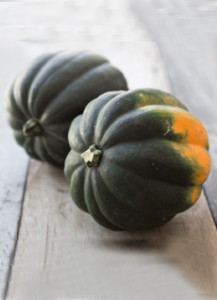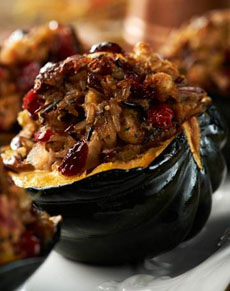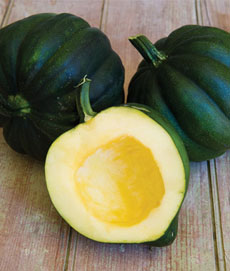Stuffed Acorn Squash Recipe For National Acorn Squash Day
 [1] Whole acorn squash (photos #1 and #2 © Good Eggs). [2] Halved and seeded acorn squash. |
Last night we were out with a group of friends, the majority of whom ordered healthy roast vegetable plates for dinner. Roasting vegetables at home arose as a topic, and surprise:
While most of us roasted sliced root vegetables, only two baked halved acorn or butternut squash. The reason given: It’s difficult (and scary) to cut the hard squash with a knife. So they purchased already-peeled and diced squash. Anyone with a sharp knife and a degree of caution can cut open a hard squash. Do not be intimidated by a vegetable! Sharpen your knife and watch this video. When you get comfortable with the process, you don’t even need to cut off the ends. We prefer to leave them on for aesthetic appeal and use this technique—a rocking knife motion—to slice the squash in half. Now there’s nothing wrong with baking the squash halves with a bit of butter or oil, salt, and pepper—or a drizzle of maple syrup. But baked stuff squash is such a festive dish. You can stuff it with absolutely anything, from grains to other vegetables, as a first course or a vegetarian entrée. It’s a great Meatless Monday dish, but you can also add sausage or other meat. One squash serves two people. The following recipe is from QVC’s chef David Venable. The photo of the recipe is below the preparation instructions. Mark your calendars: September 7th is National Acorn Squash Day. > The history of squash is below. |
|
|
RECIPE: BAKED STUFFED ACORN SQUASH This recipe uses wild rice, but you can use barley, brown rice, quinoa, or another grain. Want a different filling? Here are more ingredients for stuffed squash. Ingredients For 4 Servings *Semi-firm cheese or semi-hard cheeses include American Swiss, Appenzeller, Asiago, Beaufort, Caciotta, Caerphilly, Cantal, Cheshire, Colby, Comte, Emmental, Fontina, Gloucester, Gjetost, Jarlsberg, Caserri, Manchego, Tête de Moine and Tomme d’Abondance, among others. 1. PREHEAT the oven to 350°F. Lightly oil and season the flesh of each squash with salt and pepper. Place the halves flesh-side down on a baking sheet. Bake for about 45 minutes or until fork tender. While the squash is baking… 2. MAKE the stuffing. Add 1 tablespoon oil to a skillet over medium heat, and sauté the onion and celery until cooked through, about 5-7 minutes. Add the chicken stock and bring the mixture to a simmer. Add the stuffing mix and cranberries. Stir and remove the pan from the heat. When the stuffing has cooled slightly… 3. SPOON it into a medium-sized bowl and add the rice, cheese, and pecans. Mix until combined. When the squash has finished baking… 4. TURN each squash half flesh-side up and spoon the stuffing into the cavity. Bake for about 30 minutes, or until the stuffing is heated through and is golden brown on top. |
||
|
THE HISTORY OF ACORN SQUASH Squash is indigenous to Central and South America. It was introduced to the Spanish conquistadors in Mexico and to the English settlers in Virginia and Massachusetts. It was easy to grow and hardy enough to store for months, providing a nutritious dietary staple throughout the winter. Acorn squash (Curcubita pepo, var. turbinata) is so called because its shape resembles an acorn. The most common variety is dark green in color, often with a splotch of orange on the side or top. Some varieties are variegated (multi-color) and newer varieties include the yellow Golden Acorn squash and white-skinned varieties. Like the other popular winter squash, butternut squash, the skin of acorn squash is thick and hard, and it is an effort to peel it. But either squash is easily cut in half with a large, sharp knife. It can then be baked, plain, or stuffed with grain, meat, or vegetable mixtures. Acorn squash is smaller than butternut squash (acorn is one to two pounds, four to seven inches long), and half of an acorn makes a convenient individual portion. It is similar in flavor to butternut. While acorn squash is most commonly baked, it can also be microwaved, sautéed, or steamed. |
 [3] Stuffed acorn squash, the recipe above (photo © QVC).
|
|
|
CHECK OUT WHAT’S HAPPENING ON OUR HOME PAGE, THENIBBLE.COM.
|
||




